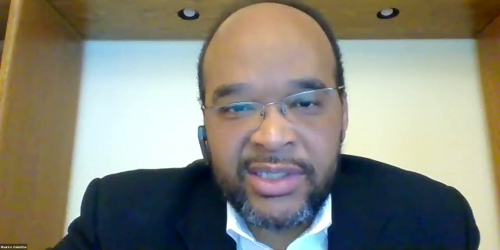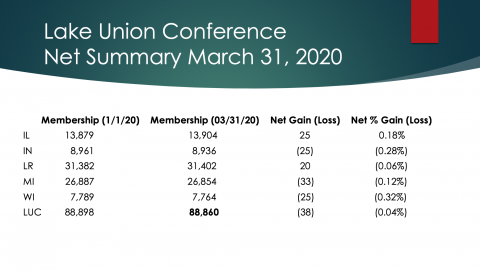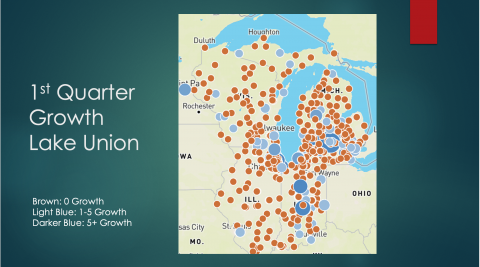
Lake Union President Maurice Valentine chaired the virtual executive committee meeting in May, and spoke of the lengths the Lake Union administration has gone to ensure that its staff would return to a safe environment, such as upgrading the HVAC system, installing touch-less faucets and 'sneeze guards' for personnel working in open spaces. He also spoke of instituting a system blue/green team system where the staff would not all be in the office at the same time, and that while they're working remotely they utilize software such as Microsoft Teams for efficient communication. He also mentioned that directors were told to look for cost-savings measures, as projections were indicating a tithe downturn in the neighborhood of 20 percent.
The coronavirus pandemic has rocked the economy, put hundreds of thousands of people across the Lake Union out of work and made an impact on our conference and educational institutions. The ripple effects were catalogued during the May Lake Union executive committee session which took place via Zoom.
While bracing for double digit loss of tithe, Lake Union treasurer, Glynn Scott, reported that in March, with two weeks of face-to-face church services and two weeks of stay-in-place (with churches livestreaming), the Lake Union year-to-date tithe was down just 4.6 percent, as compared to NAD’s YTD of 4.9 percent.
Scott said that the Union has taken steps to reduce the 2020 budget expenses through means such as: hiring freeze, travel moratorium, 12 percent reimbursement reduction in mileage, no staff pay increase for 2020, freezing all non-essential expenses, and lowering the building temperature.
One institution reporting serious challenges to its budget was Andrews University. President Andrea Luxton remarked on the rapid events leading up the decision to quickly close the campus and move to a completely online environment. In the six weeks between closing and graduation, the University had a loss of about $2 million in revenue; that number is expected to double before the fall. As a result, more than 160 employees were furloughed until August 1.
“We were able to get some money that goes to universities and colleges, and half of that goes to students,” she acknowledged. “We've had $600,000 from the government to go to students, mainly for food and rent, and boy, they need it. Some of them have nothing and the unfortunate thing was that in the final roll out, International students were cut out, and they are the ones that are struggling most. They can't get home. They can't work. Their whole income sources have just been cut and they are stuck.” Fortunately, through fundraising efforts, they secured contributions of $200,000 from supporters of the university.
In addition to the tithe drops, several conference presidents discussed the challenges of working remotely, as well as carrying out normal church functions such as weddings, baptisms and funerals. Lake Region experienced a disproportionate impact of the coronavirus on the African American community, with Detroit as one of the epicenters of the devastation.
Lake Union vice president Carmelo Mercado said that as a result of this emerging issue of racial health disparities, pastors in the Lake Region and Michigan conference pastors ministering in the Detroit area are interested in addressing this disturbing societal challenge.
Despite these difficulties laid bare by the pandemic, the leaders reported reasons to celebrate. Indiana president Vic Van Schaik captured the earlier mood of excitement and anticipation as Indiana prepared to host large evangelistic campaigns ahead of the General Conference Session previously slated to happen in Indianapolis this summer. “God had opened up many, many doors,” he explained. “It was just incredible, the relationship that we had with It Is Written, NADEI, the Lake Union, the NAD, Pathway to Health. God provided the Lucas Oil Stadium free of charge for the event, and we had this partnership where It Is Written had invested a lot in Indiana and 70 percent of our churches were going to be involved in doing meetings.”
Only for the pandemic to hit right before the launch of these events.
“I still remember that moment on Sabbath when everything kind of slowed down and a sense of sadness and disappointment developed. Then the question: ‘God, where do we go from here? What would You have us to do?’”
Within a week, the It Is Written meetings were transformed into a virtual national event. Before the series went live, 67,000 Hoosiers had registered. “It's been exciting to see how God has turned this around. I think of the text in Genesis 50, verse 20,” said Van Schaik. “Satan intended to bring evil but God meant it for good, to accomplish His greater purpose of saving many souls for the Kingdom. I believe we're not going to do evangelism in the same way after this. I think we're going to be looking at how to use technology in a whole new way.”
Lake Region president Cliff Jones reported they received good news that the sale of their old conference building was nearing completion and that ministry was continuing to go forward with the airing of various online worship and educational programs.
Meanwhile, in Michigan, Jim Micheff ticked off a list of several enterprising endeavors bearing fruit from Sabbath School, Youth and Public Campus Ministry departments. For instance, the Sabbath School and Personal Ministries departments were providing very popular programming.
Illinois president Ron Aguilera and Wisconsin president Mike Edge said they discovered silver linings as it related to communication and technology. Aguilera said they have discovered new opportunities for “learning how to best steward our technology, not only today but moving to the future.” Edge was grateful for the opportunity to “listen to three or four of our pastors in our conference preach and to see pastors realize the value of media as a powerful tool.”
Mercado, in his Multicultural report, announced that Hispanic and refugee pastors are adapting their ministries to the churches and communities by creating new social media broadcasts which are attracting many people who had not been previously attending church.
In other non-pandemic related matters, executive secretary Steven Poenitz reported the Lake Union took a dip in membership with transfers out to other unions and limited baptisms and professions of faith coming in. Membership at the end of March stood at 88,860, a .04 percent decrease from previous numbers.

